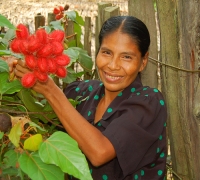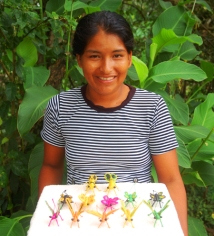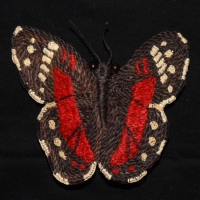In 2007, I spent a month near Jenaro Herrera on the Ucayali River. While I spent most of my time studying copal resin ecology at a research station, I also wanted to meet local artisans to see if CACE could help market any of their handicrafts.

Dora Tangoa with achiote fruit pods. Photo by Campbell Plowden/CACE
One Saturday afternoon, I met Dora and her small group of fellow artisans at her home and watched them lay out some bracelets and necklaces made with rainforest seeds and simple bags woven with chambira palm fiber. I bought some samples of each and asked them to make some chokers with certain colors at my teenage daughter’s suggestion. CACE sold enough of these in the U.S. to buy some supplies for the public school when I returned in 2008. That summer, Dora took us out to her field and showed us which plants provided the seeds and natural dyes to make her crafts.

Rosa Mozombite Tangoa with chambira insect ornaments. Photo by Campbell Plowden/CACE.
Sales of the loose woven bags (called “xicras” in the local market) were never great for us, however, and over the next few years, sales of the seed jewelry slowed to a trickle. In 2011, we started developing Christmas tree ornaments with artisans in the Ampiyacu, and I invited Dora and her group to come up with ideas of their own. Dora wove a miniature pot, her aunt Hilda made a miniature plate, her niece Doilith wove chambira stars with seeds, and her teenage daughter Rosa made little butterflies and grasshoppers. We did so-so with the first three types, but the insects were an immediate hit.

Chambira fiber bee ornament. Photo by Campbell Plowden/CACE
Over the next few years, we tested different colors, sizes and types of new critters – sometimes on purpose and sometimes by accident. We learned (probably not surprisingly) that people much prefer pink, yellow an orange critters over black ones with any color. One batch of giant purple bees were produced due to misunderstanding over the Spanish meaning of “fuxia.” So, some ornaments have sold very well while others are lingering long in our inventory even at “clearance” prices.

Chambira palm fiber butterfly ornament. Photo by Campbell Plowden/CACE
Last year, we asked Dora and company to increase the number of legs on the critter ornaments from four to six so they would have one more realistic element on them. This past trip, I asked her group if they would like to try to advance this process a step further by trying to weave replicas of specific types of insects. I had downloaded a variety of photos of butterflies, dragonflies and bees from the internet onto my laptop and went over each image with them at Dora’s big table in front of her house. They embraced the challenge – each one agreed to make a prototype of one or two new “species.”
I checked in a few days later and was thrilled to see the progress of Doilith’s Amazon darner (Anax amazili) which closely represented the dragonfly’s shape, colored tail bands, and fine lacey wings. Hilda’s blue morpho butterfly also had a lot of promise. Dora had skillfully captured the green orchid bee’s hind legs used to carry pollen and resin back to its nest, but her “ronsapa” bee needed more work since its head resembled a bull-dog snout.

Amazon darner dragonfly and chambira palm fiber ornament. Photos by Bob Thomas & Campbell Plowden/CACE
I admit that most members of the public neither know nor care if these ornaments are anatomically correct, but I do hope we can develop models with our partners that will be attractive enough to sell and gradually educate buyers about real rainforest critters along the way. It seems this type of understanding can only help to increase people’s desire to preserve the forest and support sustainable livelihoods for its traditional peoples.
It has been rewarding to see that creating and selling more crafts has allowed Dora and her relatives to improve their houses and invest more in their children’s education. I am glad that CACE has played a role in this process.


